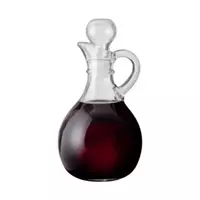Balsamic vinegar

If you want to surprise guests, give a new sound and original taste to a well-known dish, add just a few drops of balsamic vinegar to a vegetable or fruit salad, a marinade for poultry or meat, and a seafood dish.
Balsamic vinegar or balsamic is first mentioned in manuscripts of 1046 as a gift that the Italian Marquis Bonifazio presented to the Emperor of Germany, Henry the Second.
Real balsamic vinegar has a richly dark color, a sweet aroma and a rather thick, viscous consistency. Its use as food is primarily characteristic of Italian cuisine. A note of balsamico is easy to recognize, even if you've tried it just once, although it's traditionally customary to add it in very small quantities. By the way, the calorie content of balsamic vinegar is 88 kcal per 100 grams of liquid product.
Blended with olive oil, balsamic vinegar can make a wonderful salad dressing that has a subtle and soft taste. In addition to lettuce, it is also used with pieces of fresh fragrant bread, which is dunked right in the piano with this exquisite sauce.
Not only the chefs of expensive restaurants, but hostesses around the world enjoy using balsamic vinegar as a marinade for vegetables and meat. In both cases, a very subtle taste of the final dish is achieved. Balsamico and various seafood shade beautifully: for example, rice with squid or salad with shrimp and avocado. If you sprinkle meat with this aromatic liquid a little during the frying process, you can achieve a new unexpectedly pleasant taste color of the culinary masterpiece.
The classic properties of balsamic vinegar are also manifested in the combination of this product in salads with cheese. Take, for example, a Mediterranean salad using green salad leaves, soft goat cheese and ripe tomatoes. But the most unusual combination of this sweet-and-sour vinegar flavour can undoubtedly be called a mix of fragrant strawberries.
Benefits of balsamic vinegar
The benefits of balsamic vinegar are indicated by the fact that it contains a number of macro and trace elements, polyphenols, pectins, organic acids and other necessary substances.
Modern cosmetology companies actively use the miraculous benefit of balsamic vinegar, since due to the content of tianins, polyphenols and anthocyanins, a noticeable slowdown in the aging process of the skin occurs. In addition, balsamic is considered an excellent antiseptic.
Damage of balsamic vinegar
Any vinegar, including balsamico, is contraindicated in cases of increased stomach acidity, as well as in case of individual intolerance to this product.
Today, enterprising manufacturers are well aware of the demand for this wonderful food additive, so they are trying in every possible way to supply a cheaper version of the product to the consumer market. The latter often contains components such as grape wort concentrate, wine vinegar, caramelized sugar, thickeners, artificial flavors and other additives. They do not carry any benefit to the body, and sometimes you can even talk about the dangers of balsamic vinegar if it is its cheap substitute.
88 kCal balsamic vinegar
Energy value of balsamic vinegar (Ratio of proteins, fats, carbohydrates - ju):
Proteins: 0.49 g (~ 2 kCal)
Fats: 0 g (~ 0 kCal)
Carbohydrates: 17.03 (~ 68 kCal)
Energy ratio (bj | y): 2% | 0% | 77%
 Español
Español Français
Français Português
Português Русский
Русский 简体中文
简体中文 繁體中文
繁體中文 日本語
日本語 한국어
한국어 العربية
العربية Türkçe
Türkçe Қазақ
Қазақ Deutsch
Deutsch Italiano
Italiano Українська
Українська
